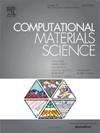高钛钢TiC/TiN非均相形核界面的第一性原理研究
IF 3.1
3区 材料科学
Q2 MATERIALS SCIENCE, MULTIDISCIPLINARY
引用次数: 0
摘要
采用第一性原理方法系统研究了高钛钢中TiC与TiN的界面关系,TiC以TiN为核心形核生长。结果表明,(111)表面的能量取决于末端原子的类型,末端ti表面的表面能低于末端C(N)表面的表面能。相反,(100)和(110)表面的能量与终端原子类型无关。表面能的顺序确定为(111)-Ti<(100)<(110)<(111)-C(N),功函数表现出相同的趋势,而稳定性则恰恰相反。在所有的界面结构中,Ti-C端原子结合的界面结构被认为是最稳定的,这可以归因于在界面处形成的共价键、离子键和金属键。成键强度主要来自于Ti-d轨道和C(N)-p轨道之间的杂化。在(111)界面结构中,通过Ti-Ti端原子结合在界面结构中形成金属键,使得界面能量最低,热力学最稳定。因此,TiC能够在TiN上异质成核,TiN的优先成核面顺序为(111)>(100)>(110)。本文章由计算机程序翻译,如有差异,请以英文原文为准。

First-principles study on TiC/TiN heterogeneous nucleation interface in high-titanium steel
A systematic study using the first-principles method was conducted to investigate the interface relationship between TiC and TiN in high-titanium steel, where TiC nucleates and grows with TiN as the core. The results showed that the energy of the (111) surface depends on the type of terminal atoms, with the Ti-terminated surface exhibiting lower surface energy than the C(N)-terminated surface. In contrast, the energy of (100) and (110) surfaces was independent of the terminal atom type. The order of surface energy determined to be (111)-Ti<(100)<(110)<(111)-C(N), the work function exhibits the same trend, while the stability is exactly the opposite. Among all interface structures, the interface structure with Ti-C terminal atomic combination was identified as the most stable, which can be attributed to the formation of covalent, ionic, and metallic bonds at the interface. The bonding strength primarily arises from the hybridization between Ti-d orbitals and C(N)-p orbitals. Within the (111) interface structures, metallic bonds were formed in the interface structure with the Ti-Ti terminal atomic combination, leading to the lowest interface energy and making it thermodynamically the most stable. Consequently, TiC is capable of heterogeneously nucleating on TiN, with the preferred nucleation surface of TiN following the order of (111)>(100)>(110).
求助全文
通过发布文献求助,成功后即可免费获取论文全文。
去求助
来源期刊

Computational Materials Science
工程技术-材料科学:综合
CiteScore
6.50
自引率
6.10%
发文量
665
审稿时长
26 days
期刊介绍:
The goal of Computational Materials Science is to report on results that provide new or unique insights into, or significantly expand our understanding of, the properties of materials or phenomena associated with their design, synthesis, processing, characterization, and utilization. To be relevant to the journal, the results should be applied or applicable to specific material systems that are discussed within the submission.
 求助内容:
求助内容: 应助结果提醒方式:
应助结果提醒方式:


